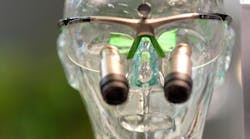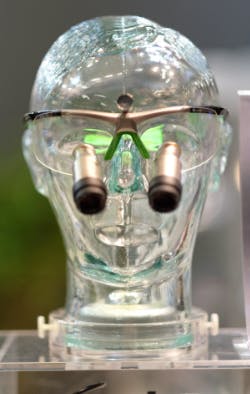Uncontorted: Illumination, loupes keep the dental hygienist’s body from twisting
By Jamie Collins, RDH, CDA
The magnification loupe was first invented back in the 18th century, with the first ones being quite heavy and bulky. Throughout the years, they have evolved to become smaller and lighter, becoming much more user friendly and affordable. Loupes are used by medical personnel, geologists, jewelers, and others, in addition to dentists and hygienists. I have even had patients asking where to get a pair for everything from embroidery to model making (until they learn the cost).
Loupes have evolved and changed throughout the years, along with the affordability of personal illumination. The back, neck, and eye saving benefits of adequate illumination and magnification are worth every penny as one piece of the puzzle to help ensure a long and healthy career.
Often, the dentist or hygienist is bent over and contorted in an unnatural position just to gain access and visualization of the oral cavity. Everything we learned about ergonomics throughout the years encourages the use of loupes to help reduce musculoskeletal complications—back and neck pain. To gain access to the oral cavity and try to see as clear as possible, the clinician will often bend and hunch forming a C-shape with the spine.
The unnatural way we sit to provide care can lead to long term musculoskeletal disorders, with one report citing nearly 70% of dental workers adversely affected. Dentistry is as back-breaking as it is rewarding sometimes; our bodies pay for the wear and tear we exhibit in a day’s work. A study published in the Journal of Dental Hygiene (August 2017) commented on the effects of magnification during instrumentation on the bodies of a pool of dental hygienists.
The study concluded there was no significant difference in the posture of the hygienists in sessions with and without loupes. However, in the pool of hygienists, 74% reported that magnification made instrumentation easier. Additionally, 67% reported that using magnification helped improve their posture. Career longevity can be dependent on what the individual is willing to invest in their future to prevent injury, whether it is in the form of physical health, saddle seats or loupes.
Many dental and hygiene schools are now requiring students to purchase loupes as part of the program, recognizing the importance and benefits of magnification. Not only for improved posture, loupes are also used to improve vision and the ability to see fine details in a small oral cavity. With better visualization the dentist or hygienists can be more accurate with diagnosis and treatment.
Having improved vision to read those little markings on the periodontal probe, detect calculus, and diagnose disease is almost a must-have in practice these days. Even clinicians who have practiced for many years are now transitioning to using loupes and lights in daily practice successfully. Starting a career with loupes can make a notable decrease in body aches and pains as well as eye strain on a daily and long term basis.
Choosing a magnification option
The options are limitless when it comes to brand, design, style, and strength of loupes. Choosing through-the-lens (TTL) or a flip-up style is a very personal preference, and most have stylish and sporty frame styles to choose from. Through-the-lens loupes require measurements with exact pupil distance and are customized to each wearer; trying on a co-workers pair will not give an accurate and clear visual picture of what a good pair of loupes has to offer.
TTL lenses cannot be adjusted once made and are usually lighter than a flip-up style loupe, which is able to be adjusted. With magnification ranging from 2x to 8x, most hygienists start and stay around a 2.0x – 3.5x in magnification selection, which is adequate.
Choosing a brand and style that fits your face is key; if they are not comfortable, you will not wear them. In choosing a new pair for myself (as my tried-and-true loupes are aging like the rest of me), I found dental conferences to be wealth of information in allowing me to try on multiple brands, and most companies will offer a show pricing discounted offer. With larger brands such as Orascoptic, Designs for Vision, and SurgiTel to name a few companies represented, you will also find smaller breakout companies such as Eclipse present—and all are vying for share of the market.
The beauty of all these companies is that there are multiple options in styles and options, including payment plans and a broad range of costs for products. Choices depend on your budget and desires, which often take some sorting out by visiting with multiple representatives to find your perfect pair. If a hygienist is accustomed to practicing without loupes for a period of time, they do take a little getting used to initially. But stick with it and notice the difference in care. With a well-fitted pair that is perfectly adjusted to your pupil distance and working length, the difference in posture and visualization is notable.
Light sources
I have used loupes for many years. Nearly 10 years ago, I added personal illumination to my existing Orascoptic loupes that I have had since hygiene school. And, let there be light! My existing close-up world of the oral cavity was illuminated beyond belief. One would think that overhead lighting would be sufficient until having light emanating from your glasses and following every which way your head moves, showing you all of the deep, dark crevices of the mouth that were previously difficult to see. Not having my head block the overhead light or adjusting it multiple times an hour was enlightening and time saving.
I started out purchasing the most inexpensive light I could find. True to form, you get what you pay for. It lasted about two years before it no longer worked. However, it continued to hold a charge for an entire day without needing charging, which is usually standard for most personal lights. It provided a great introduction to personal illumination and proved to me how much I relied on it. Once it stopped working, I very quickly replaced it with an upgraded personal light source.
With a strong and focused beam, I rarely use the overhead dental light and rely solely on the personal illumination, with a battery source that can last almost two days before needing recharging. It has allowed me to provide treatment to wheelchair bound patients who are unable to transfer to the dental chair where a traditional overhead light would not have been useful.
Light sources are transitioning, and upgrading the options is just as quick as the loupes they pair with. Gone are the days of a headband with a bulky light attached. Most personal lights are now small, cordless, and can attach to a variety of different loupes and frame models directly.
Lightweight LED lights shine bright and focused to ease eye strain. They illuminate the world at your fingertips; it is difficult to treat what you can’t see.
The latest models from multiple companies are cutting edge with wireless lights that utilize rechargeable batteries that can provide at least eight hours of light before needing a charge. SurgiTel has created the Odyssey Wireless LED—a cordless, touchless light that eliminates the need to remove gloves to change settings or turn off and on while working. Spark is Orascoptics wireless and rechargeable light, with the VX1 being a self-contained light and loupe all in one— all complete it is less than six ounces in total weight. Most loupes on the market now are lightweight and measured in ounces, not too notably different than a pair of safety glasses. Lumadent provides an affordable and good quality light on the market with multiple connections for many different loupe brands, and has proven to be a reliable light source.
Teledentistry
The changes in how we are able to provide dental care to various populations of the country and world indicates a change to the way we can practice. With the adoption of direct access care for hygienists and teledentistry becoming prevalent, we also adapt our services to accommodate care to vulnerable populations. Providing treatment to the elderly in care facilities can limit the tools we have at our disposal in a physically strenuous environment. Loupes and personal illumination replace the need for an overhead light and can allow the clinician to provide an easier evaluation and treatment providing the best possible comfort for the patient and the provider.
Where patients are not able to be supine for treatment—and we contort and adapt for better visibility—having the best possible tools at our disposal can make the difference in our bodies as well as the ability to diagnoses needs of the patient. Mobile dental clinics and in-school sealant clinics are all examples of where personal illumination can be a life-saver with limited equipment available.
Teledentistry opens the avenues for vulnerable populations to receive treatment where they might not normally have access to care. We use an intraoral camera and technology to provide a diagnosis and treatment at various clinics or makeshift clinics, having small portable equipment that works well makes the job more efficient, and loupes with illumination fit the bill. Dental missions are gaining in popularity among our profession, travel to other countries to treat an underserved population providing the basic dental needs is a fulfilling quest. With limited resources and items, you are able to travel, and having a small light and magnification in hand can be a luxury as much as a necessity.
Whether you are a new or a seasoned hygienist do your body a favor, invest in your career and musculoskeletal health. Investigate the possibility of loupes to incorporate into your daily practice and relieve body pain associated with hunching towards the patient to see the posterior of the molars.
Though the initial investments can be a barrier, it’s worth every dollar if it can help to preserve the career choice we have all made to provide care for others. Clear and magnified vision in conjunction with illumination will change the way you practice and improve ergonomics and patient care for years to come.
Jamie Collins, RDH, CDA, is a clinical practicing hygienist in Idaho and Washington states. She has been in the dental field for nearly 20 years, both as an assistant and hygienist. With a passion for patient care, especially those with higher risk factors, Jamie enjoys sharing the tips and tricks of dental profession through speaking and writing. In addition to clinical practice Jamie is also an educator, has contributed to multiple textbooks and curriculum development, and contributes as a key opinion leader. Jamie can be contacted at [email protected].
Reference







